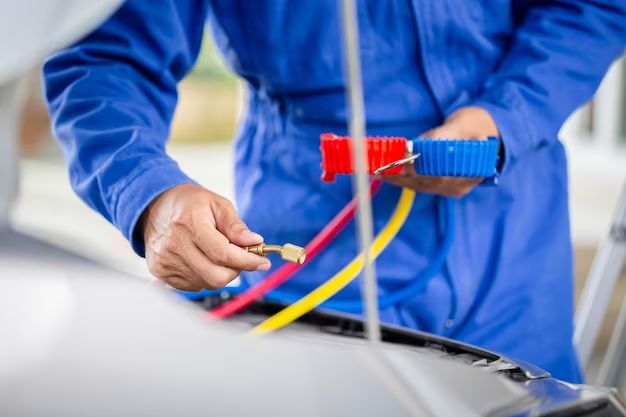With summer in full swing, air conditioning units are working overtime to keep homes cool. But after months of use, the refrigerant levels in the AC can start to drop, reducing cooling efficiency. Many homeowners wonder if it’s possible to recharge their AC unit themselves instead of calling an HVAC technician. The answer in most cases is yes – with the right tools and precautions, recharging your AC system with refrigerant (also known as Freon) is something a handy homeowner can tackle. This article will cover the steps involved in DIY AC recharging, things to keep in mind, and tips for doing it safely.
Page Contents
What causes refrigerant levels to drop?
There are a few common reasons why an AC system may need more refrigerant:
Small leaks
Even a very minor leak in the pressurized refrigerant system can gradually cause refrigerant levels to drop over months of use. Once levels get too low, cooling performance will start to decline.
Installation issues
Incorrect installation or improper sealing of fittings can sometimes allow small amounts of refrigerant gas to leak out. Having a professional check for leaks during installation can prevent this.
Major repairs
Any major repairs like replacing the compressor often require discharging all the refrigerant from the system. Once repairs are complete, the system will need to be recharged with the factory-recommended amount of refrigerant.
Signs your AC needs a recharge
Here are some common signs that refrigerant levels may be low and your AC could benefit from a recharge:
- Higher electric bills – The AC will run longer to try to reach the desired temperature if refrigerant is low.
- AC not keeping house cool – If the AC can’t reach the set temperature, insufficient cooling levels are likely.
- AC not cold when idling – The air coming from the vents may not feel cold even when the AC isn’t actively cooling.
- Intermittent cooling – Cold air comes on and off instead of constant flow.
- Unusual noises – Hissing, gurgling or bubbling sounds can indicate refrigerant leaks.
If you notice any of these warning signs, consider recharging your AC system.
What you’ll need
Recharging an AC system requires a few specialized tools and parts:
- Refrigerant gauges – Used to measure pressure levels and charge the new refrigerant.
- Refrigerant tank – Contains the new R-22 or R-410a refrigerant to recharge the AC.
- Hose – Connects the gauges to the refrigerant tank and AC ports.
- Hex wrenches – For opening the AC access valves.
- UV dye – Used with some recharge kits to detect future leaks.
DIY recharge kits contain all the equipment needed. The refrigerant type must match what’s specified for your AC model.
Step-by-step recharge process
Here are the basic steps to safely recharge your AC unit:
1. Locate the access valves
The low and high side access valves are located near the compressor and are usually covered by metal caps. Remove the caps with the hex wrench.
2. Attach the refrigerant gauges
Securely connect the hose ends to the gauge set and AC access valves for a tight seal.
3. Test pressure levels
With the AC turned on, check the gauge readings. The low side should read between 25-40 psi. The high side should read between 200-300 psi.
4. Run the evacuation process
Hook up a vacuum pump (included with some kits) to the gauges to remove any moisture or contamination.
5. Connect the refrigerant tank
With the gauges still attached, remove the vacuum pump and connect the refrigerant tank’s hose to the low side valve.
6. Recharge the system
Slowly add refrigerant until the sight glass shows clear or the gauge reads the factory-recommended level, then close the valve.
7. Disconnect gauges & reinstall caps
Once fully recharged, detach the hoses, reattach the valve caps and run the AC to check that cooling improves.
Safety tips
To avoid potential hazards, keep these safety guidelines in mind:
- Use protective eyewear and gloves when handling refrigerant.
- Only perform the recharge outdoors in a well-ventilated area.
- Avoid breathing in refrigerant vapors directly.
- Monitor the gauges and recovery cylinder – stop immediately if anything seems abnormal.
- Call a professional if leaks, electrical issues or other problems are suspected.
Recharging AC systems involves high pressure and flammable refrigerant. Use extreme care to avoid accidents.
Should you DIY?
For homeowners who are very handy and understand ACs, recharging yourself can save on service costs. But for those less experienced with HVAC systems, hiring a professional is recommended.
If you have any doubts about whether leaks exist, if the refrigerant type is correct, or if the system has other underlying issues, it’s best to call a technician. They have the tools and knowledge to diagnose and fix any problems.
Below is a table summarizing the key pros and cons of DIY vs. pro recharging:
| DIY Recharge | Professional Recharge |
|---|---|
| Lower cost | Expert service |
| Convenience of home repair | Diagnose and fix leaks |
| Trial and error process | Ensure proper refrigerant amount |
| Safety risks if done improperly | Verify no system issues |
Conclusion
Recharging an AC system is a project many DIYers can complete if they have the proper equipment and take safety precautions. However, the recharge may only provide a temporary fix if leaks exist. Calling in an HVAC technician to inspect, diagnose, and service the entire system is the best way to identify and correct any underlying problems. Their expertise can get an underperforming AC unit back to providing reliable cooling for your home.
